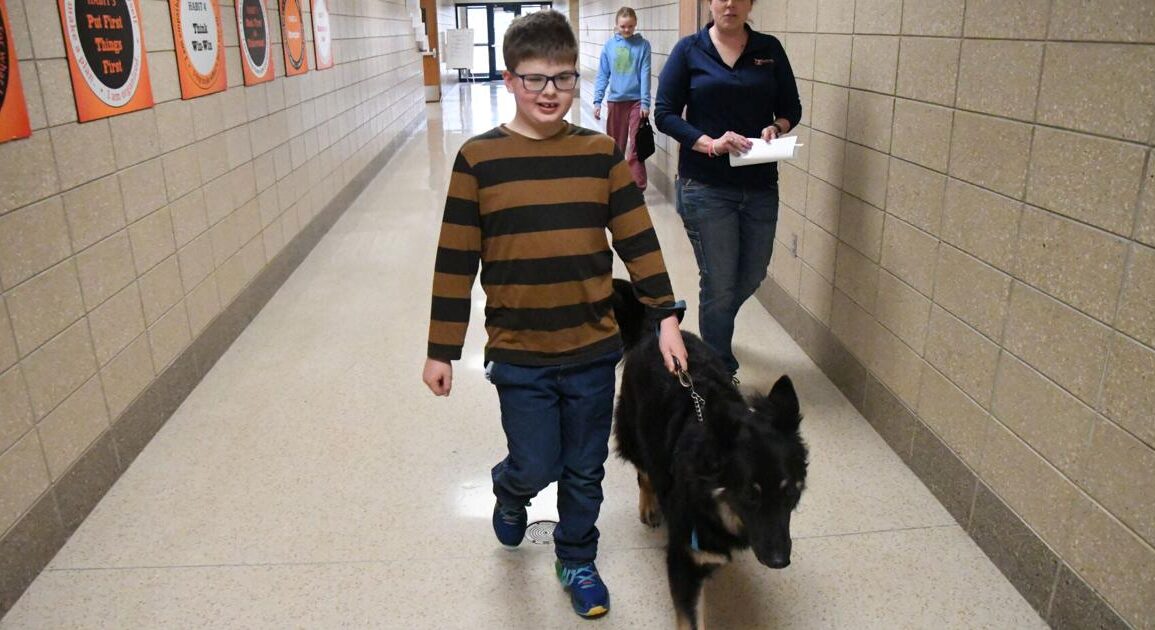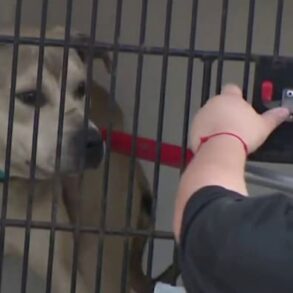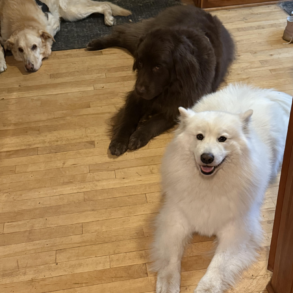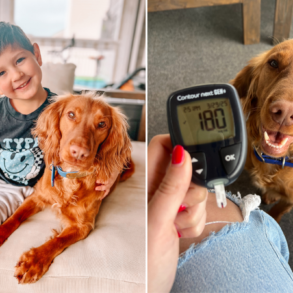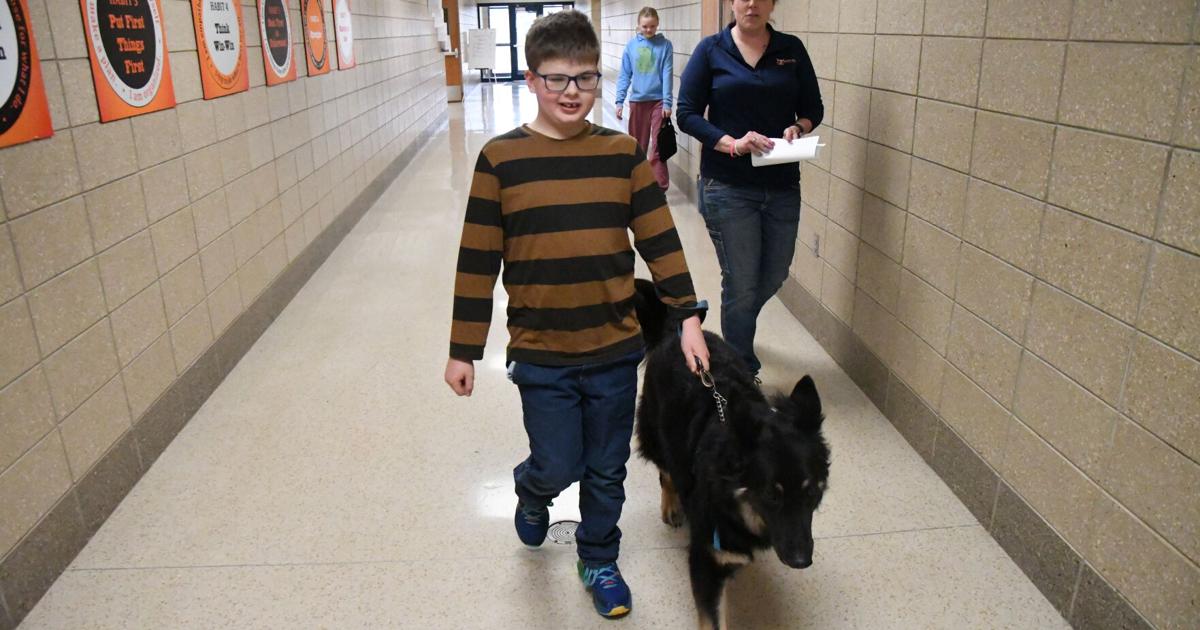
REGIONAL—When sixth-grader Damien Beldt walks through the hallways of Sheldon Middle School, he is accompanied by his king shepherd, Remi.
“When the kids see Damien walking down the hall and they say, ‘Hi,’ they go, ‘Hi Damien. Hi Remi,’ like she’s just an extension of him,” said his mother, Chelsea Beldt.
A large dog with thick fur and pointed ears, Remi is distinguished by her vest, which indicates she is a service animal.
Twelve-year-old Damien is diagnosed with epilepsy and has numerous developmental delays. For the last two years, Remi has almost never left Damien’s side.
“We talked about getting him a dog to give him some independence,” Chelsea said. “At school, he wasn’t even allowed to walk from one classroom to another without an adult due to him having seizures.”
Remi, who is a German shepherd and malamute mix, is a seizure alert dog, trained to find or alert others when a convulsive seizure occurs so they can help ensure Damien’s safety and provide assistance.
Seizure alert dogs cannot be trained to predict seizures, but anecdotal evidence indicates that some dogs, like Remi, naturally exhibit this behavior, which can be encouraged and refined with training.
When Remi accompanies Damien into the classroom, she mostly curls up in a corner. However, she remains alert.
“She watches him from her little corner — she rolls up in a ball out of the way,” Chelsea said.
According to Chelsea, Remi is so closely attuned to the subtleties of Damien’s demeanor, she can detect absence seizures, which often last only seconds and are characterized by a blank stare or the appearance of daydreaming, although the person cannot be brought out of the seizure.
“She is licking him. She’s tugging on his shirt — she won’t stop moving him,” Chelsea said. “She may not realize what is wrong, but she knows something’s different.”
According to the Americans with Disabilities Act, “service dogs are individually trained to perform specific tasks and work with people with disabilities,” which include “physical, sensory, psychiatric, intellectual or other mental disabilities.” Service dogs, which fall under the broader umbrella of “working dogs,” perform tasks specific to the needs of their handlers.
Since Remi began accompanying Damien to school at the end of fourth grade, Damien has not experienced any convulsive seizures, although he experienced dozens in the stretch of a single month the year before Remi joined the Beldt family. However, Damien may have more convulsive seizures as he continues to experience bursts of physical growth and brain development.
Whatever course his epilepsy takes in the future, however, Damien and Remi now function as a pair, and they are essentially inseparable. Remi goes to Damien’s medical appointments, accompanies him in restaurants and toy stores, and every night, she sleeps right next to his bed.
They do everything together, Damien said, but Remi is not interested in his favorite television program.
“She doesn’t understand ‘Paw Patrol,’” Damien said.
The pair’s inseparability is a protected legal right, and it is guaranteed by federal law.
“The only place she goes that is not with him is to the groomers, and he goes to drop her off and he goes to pick her up,” Chelsea said. “Any of her vet appointments he goes with — because she has major separation anxiety.”
The provisions for service dogs under the Americans with Disabilities Act are broad, and a service animal is allowed to accompany its owner anywhere members of the public are permitted to go, so long as the animal is under the control of its handler. Emotional support animals and therapy dogs are not granted the same protections, and they are trained to provide a different variety of services in different contexts.
Libby Karssen is a professional dog trainer based in Orange City who provides group-based and individual obedience courses to owners and their pets through her business, Karssen K9s. However, she also has trained, or assisted in training, a variety of working dogs, including service dogs, police K-9s and certified therapy dogs.
“That’s the difference — a service dog is specifically trained to work for one individual person,” Karssen said. “A service dog for medical reasons is essentially like a dog taking the place of a medical device, so instead of someone walking with a cane, they can walk with a dog with a walking harness.”
Service dogs can act as guides for the blind or provide alerts to common sounds for the deaf. They might be trained to assist individuals diagnosed with autism spectrum disorder to recognize and respond to different sensory inputs. In the case of Anastasia Janssen, a service dog can detect the subtle changes in her scent that indicate a condition of hypoglycemia.
‘I laid the groundwork’
When Janssen arrived as a first-year student on the Sioux Center campus of Dordt College, now Dordt University, around a decade ago, she moved into the dorms like the rest of her cohorts, who carted boxes and bins and minifridges into their tiny living quarters. Janssen, however, also was accompanied by her service animal, a miniature goldendoodle named Ari. At the age of 7, Janssen was diagnosed with Type I diabetes, and Ari is a trained diabetic alert dog.
“A diabetic alert dog can actually smell a blood sugar change upward of a half an hour before modern technology can detect anything starting to change,” the 27-year-old Janssen said.
Along with detecting changes in scent, diabetic alert dogs can also be trained to retrieve something high in sugar — a juice box or fruit snacks — and bring them to their handlers, who may be unable to do so for themselves due to dangerously low blood sugar. Janssen’s diabetes has always been well-managed, but her mother decided a diabetic alert dog would provide an extra measure of security.
“It gave her peace of mind,” Janssen said.
Janssen grew up in a small town in northwestern Illinois and with the help of a professional trainer, she and her mother began training Ari near the end of Janssen’s eighth-grade year in school. Janssen was the first person in her hometown to have a service dog.
“It was a learning curve for everyone,” she said.
Janssen also was the first student to have a service dog at Dordt, where she met her husband, Jonathon Janssen, who grew up in Hospers. The couple now lives in Mankato, MN.
“We had conversations with the student housing committee, and we explained what fair housing says and this is what the federal law says,” she said.
The responsibility of educating others about service animals could sometimes feel like a burden, especially when Janssen was a new college student trying to navigate an unfamiliar world of expectation and responsibility.
“But I think that kind of laid the groundwork for their understanding of what a service dog was,” she said.
Janssen sometimes found herself in the role of educator and advocate off campus, too.
“I only really remember one time being kicked out of somewhere illegally — it was at a coffee shop in northwest Iowa,” she said.
According to the ADA, service animals are permitted in any space that is accessible to the public, and there are only two questions a business owner can ask a visiting service dog team: “Is that a service dog required for a disability? And what tasks has the dog been trained to perform?” Service dog teams do not need to show any certificates or documentation to access public spaces. So, when Janssen encountered resistance at the coffee shop in question, she stood up for herself, hoping to spare others the same denial of their rights in the future.
“I was like, ‘Actually, according to the ADA, I have a right to be here,’” Janssen said. “‘This is a public space, and this is my trained animal that I’m allowed to be in this public space with. This is something I need — this is a medical tool.’”
The pair were asked again to leave. Janssen, who is not inclined to make a scene, decided not to press the issue. She left the coffee shop with Ari trotting at her side. She still wonders if she should have said more.
“It bothers me to this day because I go back, and I’ll read the reviews, and some other people have had issues with the same coffee shop,” she said.
‘I couldn’t be alone’
Janssen and Damien have service dogs because of a medical diagnosis, but service animals also can perform important tasks for individuals with psychiatric conditions.
For years, 31-year-old Braxton Kramme did not go anywhere without his dark-haired boxer, Elsie, a psychiatric support animal. Elsie, at 10 years old, is approaching retirement, however, so Braxton, with the help of two professional trainers, has begun the diligent work of training Eevee, a black Labrador and Elsie’s eventual replacement. Still, Elsie is a veteran, and she’s the one he relies on to go out in public, take public transit and live independently in his home.
“Without Elsie, I don’t have the ability to cope with the high anxiety — it’s just so high,” Kramme said.
Braxton is diagnosed with severe anxiety, panic disorder and depression, and by the time he was in his early 20s, it had become next to impossible for him to navigate public spaces on his own. His ability to live alone and maintain his independence also was beginning to crumble.
“I couldn’t be alone at night,” he said.
Braxton was living on his own in an apartment in Sheldon at the time, and he began to experience debilitating panic attacks — at home and in public. Kramme remembers a time he was leaving a business in downtown Sheldon and froze.
“It was before Elsie,” he said. “I couldn’t even walk to Ben Franklin, not even a block away, because I just panicked.”
In distinction to an emotional support animal, Elsie is trained to perform tasks that are specific to Kramme’s disability. She is trained to provide therapeutic support in response to Kramme’s cues, including behaviors he himself is not aware of, like anxiety-induced fidgeting.
“It’s like a fidget alert,” Kramme said. “What she’ll do is she’ll nudge my hand, and she’ll keep doing it until I pay attention to her, and at that moment, it breaks my focus from whatever’s happening and allows me to focus on her instead.”
Eevee is only 14 months old, but she already has come a long way in obedience training. When Kramme gives her basic commands, he uses words from languages other than English to prevent Eevee from responding to anyone but him in public — he uses the German word “plotz” for “sit” and the word “Accio” to recall Eevee to him if she’s wandered.
“OK, that’s not a language,” Kramme said. “That’s ‘Harry Potter.’”
Eevee’s more intensive training in specific tasks will begin early in April, after she heals from her recent spaying surgery. Kramme did much of Elsie’s training himself, but he also has worked with professional trainers, including Karssen, whose guidance and expertise he goes on to implement on his own. Using the same training manual he used with Elsie, Kramme will spend the coming months training Eevee to perform tasks like deep pressure therapy.
“She lays across my lap to help calm the nervous system,” he said.
Eevee already has shown a natural inclination to provide tactile stimulation by licking Braxton’s face, a disability-specific task that can disrupt his anxiety response and performed in response to crying and other behaviors.
“I think she likes the taste,” he said.
Kramme hopes to train Eevee to perform tasks Elsie never performed, too, like retrieving his medications when he needs them and helping him wake up to his alarm. Without a service dog, Braxton would not be able to continue to live independently, according to his mother, Angi Kramme.
“He’d have to be in a group home, and there’s none here,” she said. “He’d move away, he’d lose his home — he’s got a nice home down the street. He’d lose his friends. He’d lose his doctors and therapists.”
Karssen has worked closely with Kramme, Elsie and Eevee during the group training sessions she offers biweekly in a rented space at Willow Lodge Pet Resort in Le Mars. The courses provide obedience training and socialization, both of which are critical for service dogs.
“A lot of pet dogs can be therapy dogs, but only like 1 percent of dogs can turn out to be service dogs — because it’s much more rigorous,” Karssen said. “It can break a lot of people, and they give up on their service dog training. I’ve had a number of people say, ‘This is too much. I can’t do it.’ But then there are some people who are like Braxton — extremely committed.”
Despite the high level of training required, the federal government does not require professional training or certification of service dogs, although many such programs and trainers exist. Many employ a Public Access Test to evaluate whether a service dog is well-behaved, unobtrusive and safe to be around others in public.
“I have a very high standard, personally, when it comes to service work,” Karssen said. “So, I also try and hold my clients to a high standard of accountability when it comes to their animal.”
Whether a service dog is trained privately by its handler, by a professional, or some combination of the two, the specialized and potentially lifesaving services a service animal provides require intensive training that typically starts during puppyhood.
“I have a quote, unquote, ‘test’ that I use, and it is to ensure that your dog is relatively ‘bomb proof’ in any situation that you could possibly bring them into,” Karssen said. “It’s a really rigorous test, and that only comes after, I say, a minimum of two years of training. That’s usually how long it takes to get a really reliable working dog.”
Service-dogs-in-training, like Eevee, are permitted in non-pet-friendly spaces, according to Iowa law, but they must be housebroken and fully under the handler’s control. Karssen said it is important for the public to be aware that service dogs and service-dogs-in-training should never be approached or interrupted while they are working.
“I always tell people, if you see a service dog, you can love them from afar — please love them from afar,” Karssen said. “Service dogs have a really important job, and to distract said dog from being able to do their job properly just puts another human being in danger.”
According to Karssen, it’s not just people who could interfere with a working dog’s ability to perform its responsibilities. Other dogs can be a problem, too.
“I’ve even known service dogs who were attacked by an off-leash dog when they were a puppy,” Karssen said. “I had that with one of my own dogs. We were doing a bunch of training, and I had really big goals for this 8-month-old puppy, and then she was pounced on by a very large dog who broke part of her spine, and she’s never been the same since. They’re dogs; they’re not machines. They have feelings and opinions and wants and needs.”
In the past, Janssen worried about encountering similar situations.
“It can be scary as a handler,” Janssen said. “It’s nice to have those two questions to protect your anonymity as a handler, but also it’s detrimental in that it allows anyone to pretend they have a service dog — because there are no federal regulations for them.”
Those worries are behind her now, however. Today, Ari is 13 years old and retired. Janssen’s diabetes continues to be well-managed, and she and her husband have a 1-year-old son, Jack.
“They’re just a boy and his dog — you would never really know that Ari had been a service dog,” she said. “Now, he gets to be in the golden years of his retirement — he’s a pet.”
It’s hard to teach an old dog new tricks, however.
“He still has those moments where I’m walking out the door and he looks at me like, ‘Why? Why are you leaving me behind?’” she said.
This post was originally published on this site be sure to check out more of their content.




